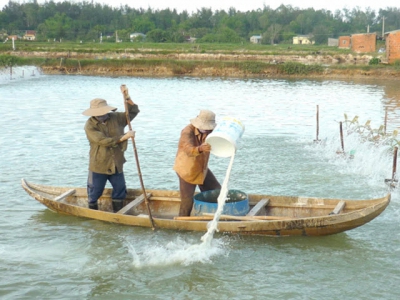Responsible shrimp farming ensures favorable income in Binh Dinh

Farmed shrimps are often contaminated with epidemics in the severe conditions of scorching hot weather; nevertheless, the danger may be minimized if shrimp production regions prioritize responsibility.
In community shrimp farming areas, farmers comply with the treatment of ponds if their shrimp are sick before releasing into the environment, to avoid spreading the disease to the common farming area. Photo: Vu DinhThung.
This year, owing to the prolonged drought, farmed shrimp in Binh Dinh were encircled by epidemics. Additionally, the year 2020 did not see a massive flood, which would have helped wash away contaminated residue from earlier shrimp harvests in downstream regions. As a result, the pond bottom and surroundings were contaminated.
Illness has damaged many regions of shrimp aquaculture in Binh Dinh's first harvest of 2020. However, the community shrimp farming regions in terms of biosecurity remain "as quiet as a jar," disease-free, and due to process compliance, the water source's environment is protected.
According to Pham Quang An, Deputy Head of Agriculture and Rural Development in Tuy Phuong District, only a few regions of farmed shrimp were afflicted by environmental diseases during the last shrimp harvest. A few ponds in Dong Dien village's 23.5-hectare community shrimp farming area and Vinh Quang 2 village's 19.5-hectare community shrimp farming area were likewise in similar condition. However, due to the high-responsible community farming regions that have not farmed only for their own benefit and have adhered to water treatment when their shrimp ponds are threatened, there is no disease transmission.
As An stated, community shrimp farming families who adhered to biological safety were accountable for all stages of the culture area's environment. The timetable for water input into the pond, in particular, must be carefully followed. When water is drained from the pond, it must be pumped into the wastewater treatment pond; it must never be drained directly into the environment.
The water in the wastewater treatment ponds is concentrated for chemical treatment by farming houses, while tilapia are discharged at a density of 0.2 fish per meter square to consume the leftovers. Water that complies with the standard is released into the environment.
Fortunately, this year's shrimp became ill while they were very young, around 1-2 weeks, providing ample time for farming families to repair ponds and lakes and grow the first harvest on time, ensuring that the district's shrimp farming area is 100% assured, according to An.
Similarly, My Thanh Fisheries Cooperative's 10-hectare shrimp farming area in My Thanh commune (Phu My district) escaped the disease due to the use of "distancing" ponds and compliance with regional environmental protection procedures, whereas other shrimp farming areas in the area saw disease spread widely.
According to Le Dinh Duc, Director of My Thanh Fisheries Cooperative, there have been numerous self-developed shrimp farming areas in the area in recent years without regard for the surrounding community, resulting in the cultured water area's environment becoming severely polluted, resulting in disease outbreaks. However, for the cooperative's 10 ha shrimp growing area, it is still fair to say that in the first harvest of 2021, all ponds produced profits.
Most of the shrimp farming area in the first crop of 2021 in Tuy Phuoc district (Binh Dinh) has been harvested, the average yield was estimated at 957.7 kg per ha, the output was 930 tons
“We organize the cooperative's ponds to "distance" the lake by 100 meters, cleanse the water source to guarantee its safety, and keep the water source's surroundings clean. As a result, the cooperative's last agricultural harvest was a success."
“I may use the instance of Dang Van Khanh as an example. He is the Chairman of the Supervisory Board of the cooperative, which has 2,500m2 of ponds. Khanh caught 6 tons of shrimp in the first crop of 2021. Khanh gets VND 100 million every ton of shrimp at the current average price of VND 100,000 per kg (100 shrimps). After all, expenses are deducted, each ton of shrimp may earn Khanh VND 40 million in profit,” Duc said.
Related news
Tools

Phối trộn thức ăn chăn nuôi

Pha dung dịch thủy canh

Định mức cho tôm ăn

Phối trộn phân bón NPK

Xác định tỷ lệ tôm sống

Chuyển đổi đơn vị phân bón

Xác định công suất sục khí

Chuyển đổi đơn vị tôm

Tính diện tích nhà kính

Tính thể tích ao




 Producing tra fish seeds to the lead in…
Producing tra fish seeds to the lead in…  The first cooperative certified for responsible aquaculture
The first cooperative certified for responsible aquaculture